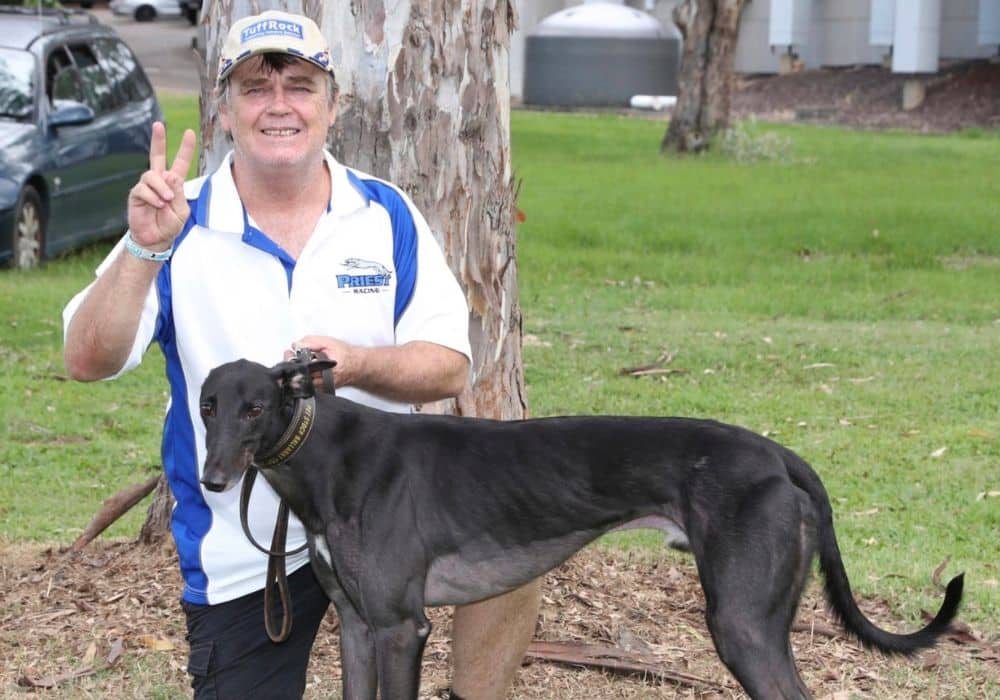
Caption: Terry Priest with Magical Trav (Photo: Just Greyhound Photos)
By MIKE HILL
TERRY Priest has had a short but highly rewarding love affair with Capalaba since arriving from the Hunter Valley two-and-a-half years ago.
The relationship has proven so successful that Priest has just completed back-to-back trainer premiership victories at the home of straight-track racing in Queensland.
“Capalaba is a great track to go racing,” said the man who has been around greyhounds for most of his life.
“It has a pleasant picnic atmosphere and it’s a wonderful track for dogs coming back from injury or those that may have some racing issues.
“Some dogs can’t handle the circle tracks and others go over the top when they hear the noise of the lure.”
He suggested the silent drag lure at Capalaba had a calming effect on some dogs.
“Dogs that can’t settle with the noisy lures just sit there quietly once they see the drag lure out in front of them,” Priest said.
“It’s really pleasing to see dogs that have had problems on other tracks win at Capalaba and the joy it gives their owners is tremendous.”
Priest finished last season with a total of 597 points (65 wins, 77 seconds and 50 thirds) more than double that of runner-up Darren Russell (217) and to top off a wonderful year he prepared the leading three runners in the Greyhound of the Year award – Magical Trav (102 points), Magical Len (87) and Apollo Eleven (72).
“It’s been very satisfying to be able to win the trainer’s premiership again,” he said.
Priest, who started in the sport in his teens, has been training for almost 30 years.
“Growing up I was into sport. I played a lot of football and cricket and my Dad had race horses, but greyhound racing was something I was always attracted to,” he said.
“As a teenager I was always walking greyhounds for friends.”
Before moving to Queensland, Priest had his share of success while based at Sawyers Gully, a small township outside Newcastle.
“I always had plenty of winners at Maitland and in the city, although nothing big,” he said.
“I had some success in second-tier finals.”
His best dogs so far have been half-brothers Old Spice (Lochinvar Marlow-Takeover Teddy) and Wild Walter (Magic Sprite-Takeover Teddy) – both Group performers.
Old Spice, in particular, holds fond memories for the trainer. He was his late father’s favourite dog.
“Dad reared him until he was 10 months of age before passing away,” the trainer said. “We decided to name the dog Old Spice as it was the after-shave Dad used. Wherever he went he wore Old Spice.”
The black sprinter contested the 2016 Group 1 Harrison Dawson (515m) series at Sandown Park and the Winter Cup (520m) at Albion Park a few weeks later after earlier breaking the Maitland 450m record.
Six months earlier Old Spice had qualified for the 2015 G1 Brisbane Cup (520m) after brilliantly winning his heat seven nights earlier.
“He led the field in the final until Dyna Double One exploded past him,” Priest said.
Old Spice ended his racing career in mid-2017 with a record of 16 wins and 17 placings from 66 starts and amassed almost $50,000 in prizemoney.
“He was special to Dad, therefore he’s special to our family, and he’s turned out to be the best dog we’ve put a collar on,” the trainer said at the time.
He admitted he had come north looking for a change.
“I’d lost Mum and Dad and I wanted to try something new and I decided to give it a go and we haven’t looked back,” Priest said.
“I have 20 dogs in work at the moment – that’s the most we’ve ever had.”
Before coming to Queensland he only ever had 10-12 racing dogs in his kennels.
And he admitted it had been a stroke of luck when he picked up Magical Trav and Magic Len from Bill and Cyndie Elson.
“They’ve played a big part in us being able to win back-to-back trainer premierships,” he said.
Based at Park Ridge, south of Brisbane, the trainer revealed he’d just purchased a 10-acre, 40-dog licensed property at Fernvale.
Although he won’t be relocating for another six months, he said Capalaba would remain his main track.
“Although we’ll be only 25km or so from the new Greater Brisbane racing complex when it’s completed, I’ll always consider Capalaba ‘home’,” he said.
Priest has big hopes for a litter by Zipping Garth from the smart sprinter Wild Miss Judy – a litter sister to his talented chaser Wild Walter.
“They’re 20 months old and out of a good damline, but they haven’t race yet,” he said.
“They’re late blossomers. It’s typical of the breed.”
And he’s very upbeat about the prospects of his regally bred youngster Born Ruby (Fernando Bale-Born Ali).
Priest’s expectations are high for the youngster who has had four placings from six starts.
“We bought her for her potential as a future stayer and brood-bitch,” he said.
“I’m hoping for a good campaign with her in coming months.”
1: How and when did you get involved in greyhound racing?
A: I grew up attending meetings at Beaumont Park in Newcastle throughout the late ’70s and ’80s. I always had an affinity with the greyhounds, catching and handling dogs for trainers and learning from the locals. I finally took out a trainer’s licence in the early ’90s.
2: Who has been the greatest influence on you as a trainer?
A: Too many to mention. I have had some great advice and help over the years but if I had to single out one person it would have to be my Mum.
3: At what age do you start preparing a pup for racing?
A: When they’re about 14 months old, but there are the exceptions.
4: How long does it take to prepare a pup for its first race?
A: Two to three months after education.
5: What makes a good pup?
A: Generally one that’s well-reared and educated, focused at the track but not over the top and obviously possessing speed.
6: Do you do anything special when preparing a young dog for its maiden compared to a seasoned performer?
A: We just slip the young ones into the bends a couple of times before they hit it at pace. Once they are travelling smoothly through the bend we step them back. Same thing applies up the straight, short slips increasing when the pups are holding their action through the line.
7: Do you have a set routine for all your greyhounds or do you vary training for individual runners?
A: To a degree, but it varies due to racing schedules etc.
8: Do you have any unique or unusual methods you would like to share in regard to training?
A: Not really.
9: Do you swim your dogs as part of your training regime?
A: We have a therapy pool we use for injuries.
10: How frequently do you like to race your dogs?
A: Four to seven days for short course and straight track runners, and seven days for 520m-plus sprinters.
11: What’s your training routine for dogs between races?
A: Recovery, injury check, hard/light work depending on the preparation. I use a 340m straight for free galloping, sawdust lanes for competition and day yards for resting.
12: Do you do all muscle work on your dogs and treat all injuries?
A: Yes, it’s a passion of mine, I’ve been learning for more than 30 years off some very talented vets and trainers. You never stop learning.
13: Do you do treat all injuries to your dogs yourself?
A: No, I don’t treat every injury myself. Those I can, I do, otherwise I use a vet.
14: Which is the best greyhound you have trained?
A: Old Spice.
15: What do you consider is the best greyhound track in Australia and why?
A: The Meadows (Melbourne) for sheer atmosphere.
16: What does the industry need most going forward?
A: The industry has gone through a dramatic form reversal thanks to the current boards doing a great job over the past five years. Participation will keep increasing with regular prizemoney boosts.
17: What is the best advice you could give someone just starting out as a trainer?
A: Ask questions, have patience and align yourself with an experienced trainer and vet.









